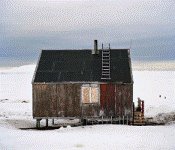Tiina Itkonen
dal 27/1/2005 al 15/3/2005
Segnalato da
27/1/2005
Tiina Itkonen
Galerie St Pere, Paris
Inughuit. 'The Arctic has fascinated explorers, adventurers, traders and whalers ever since ancient times. And since the beginning of the 1990s, I have been searching for my own Ultima Thule, my place in the Far North. I was enchanted by the story of the Mother of the Sea and, in 1995, it inspired me to set off for the place where the story originated in Greenland.' T.Itkonen, finnish contemporary photographer.

Inughuit
"The Arctic has fascinated explorers, adventurers, traders and whalers ever since ancient times. And since the beginning of the 1990s, I have been searching for my own Ultima Thule, my place in the Far North. I was enchanted by the story of the Mother of the Sea and, in 1995, it inspired me to set off for the place where the story originated in Greenland. My search for the Mother of the Sea took me to the Polar Eskimos of the northernmost part of Greenland. The lack of haste, the friendliness of the people, the silence of the glaciers and the peace of the landscape compelled me to return to Northwest Greenland in 1998 and 2002.
These memories take me back to Thule, to Northwest Greenland. When I close my eyes I am in Thule, and the silence is perfect. Blueish light dances across the snow; the icebergs glow turquoise. The silence is broken by a loud crack. An iceberg splits, creating new, smaller icebergs. In an instant, the light transforms the landscape from beautifully mellow to frighteningly sombre. In Thule there are no roads that I could take to get away. I follow my own paths. In Thule there are no trees: I can see the horizon far off in all directions. I am incapable of judging distances. I am not used to seeing this far.
Here everything happens immaqa agaqu  maybe tomorrow. And again the next day, they say immaqa agaqu. Polar Eskimos live according to the weather and the seasons. If the weather permits, the men set out to hunt, while their families may travel to a neighbouring village to visit relatives  even in the middle of the night. Nobody is in any hurry anywhere. There is as much time to do things as they require. There is also time for other people. They visit each other, play cards, mend hunting gear, sew fur clothes, do beadwork, play the organ or just are. And nor is there any need to talk; you can simply be quiet. During the four-month OEday¹, there is really no need to sleep, since you get a lot of sleep during the four-month night.
On my first trip, it was hard to get to know people, because I did not speak the Polar Eskimo language. I learned some simple phrases about the weather from an English-Greenlandic dictionary. I could say sila nuanneq  beautiful weather  or issippoq  it is cold. My Greenlandic vocabulary expanded rapidly when I lived with people. On my second and third trips, I was able to talk about subjects other than the weather.
The polar-bear scalp I was given by Taateraaq takes my thoughts to Savissivik. Hunting trips with a dogsled, spending the night in a tent on the edge of a glacier, catching little auks with a net on the slopes of a mountain, walks on the ice in the morning sun, taking part in a dogsled race, football matches in soft snow, a skiing competition without ski poles  all unforgettable experiences.
Now and then, I hear news from Thule. Juulut rings from Qaanaaq and tells me when the first snow is falling and whether you can drive a dogsled across the ice. I also get to hear when Aqatannguaq from the neighbouring village has a birthday or when Taateraaq, the oldest person in Savissivik, has come on a visit to Qaanaaq. E-mail messages from the villages tell me that life goes on as before.
On my first trip to Greenland, I was told I would definitely be coming back. According to a Greenlandic tale, a human being can turn into a qivigtoq, run around the fells, live there, and finally die there. My desire to return to Greenland goes beyond reason. On my third trip there I tried to shake off this OEmadness¹ and leave it wandering in the northern landscapes, like a qivigtoq. I did not succeed".
Tiina Itkonen
Biography
Finnish contemporary photographer Tiina Itkonen (b.1968) studied photography at the school of Art Communication in Turku and at the university of Art and Design Helsinki. She has been exhibiting in Finland and abroad since 1996. Her works are in the following collections: Moderna Museet in Stockholm, Helsinki City Art Museum, The finnish Museum of Photography and the finnish State Art Collection. Tiina Itkonen was "Finnish Young Photographer of the Year 2003" and the Fotofinlandia finalist in 1996 and 2004. She has spent four months living with Polar Eskimos in Northern Greenland during 1995, 1998 and 2002, on two of these occasions with Eva Jansson.
Contact infos / presse : Elisabeth Tessier
Galerie St Pere - 19 rue des Saints Peres - 75006 Paris
Opening hours : from Tuesday to Saturday from 11am to 1pm - from 2pm to 7pm or by appointment



